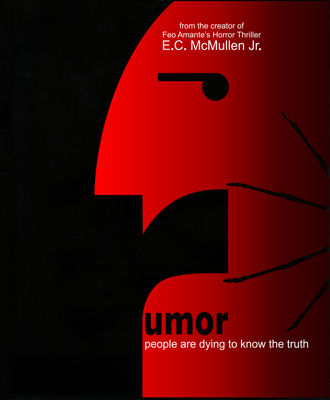 |
 |
Review by E.C.McMullen Jr. |
|
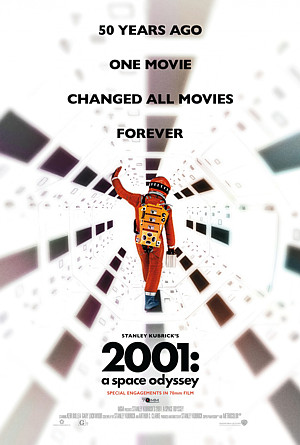
2001: A SPACE ODYSSEY- 1968USA Release: April 3, 1968 MGM Rating: USA: G |
|||
I recently watched the 70mm print of 2001: A SPACE ODYSSEY, released exclusively in IMAX.
The original 1968 movie trailer
Under the guidance of director Christopher Nolan, this movie is remastered both in visual and sound. The 70mm was a piece of cake, since Stanley Kubrick (THE SHINING) originally shot it on Super Panavision 70 cameras for Cinerama - the ultimate giant screen presentation of its day.
At some point in the journey through time of Feo Amante's Horror Thriller, I'm sure I must have said, "I won't be writing a review of 2001: A SPACE ODYSSEY, since that's just pure Science Fiction."
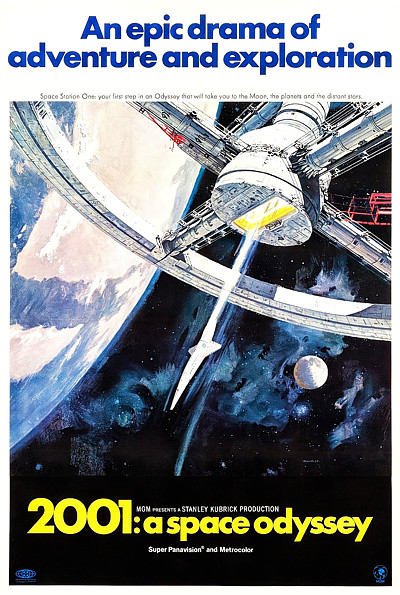 But really, it never was "just pure Science Fiction."
But really, it never was "just pure Science Fiction."
Writer, Arthur C. Clarke knew that from the beginning, as he was told at their first meeting,
"Stanley was determined to create a work of art which would arouse the emotions of wonder, awe, even, if appropriate, terror"
- Arthur C. Clarke
Originally billed as an "Epic drama of adventure and exploration", tons of press and copy has been devoted to 2001: A SPACE ODYSSEY, but to my knowledge, never in a way that captures the ethos of this website.
So let's revisit 2001: A SPACE ODYSSEY from Clarke and Kubrick's perspective of Terror.
This movie is a themed collection and we begin with the first story, The Dawn Of Man.
Here our ancestors are vegetarians. They live in a bleak desert near an oasis and scrabble for sustenance from whatever plants they are able to eat.
Day and night they live in terror as they are food for predators and helpless to do anything about it. They are neither strong enough to fight or fast enough to run away. They can do nothing other than cower and die.
One day a larger group of primates come and, in a brief battle, take control of the oasis, driving the weaker group out into the desert, away from water, to die.
Without the food of vegetation around the oasis and the water itself, existence looks bleak for our ancestors. Predators growl and prowl in the night.
TRIVIAIn addition to Arthur C. Clarke, Stanley Kubrick also had the help of Carl Sagan as an additional Science Advisor. The last thing Dr. Frank Poole hears from his parent's recorded birthday wish is his father saying, "See you next Wednesday." 1939: The Bell Labs Voder. The first electronic voice. |
Come morning though, there is a startling discovery. When they wake, a massive black monolith stands before them mere feet away.
After their initial shock and fright, the primates approach, going so far as to touch it.
Later, while digging for food among the sun-bleached dried bones of other animals that also perished in the desert, one of our ape-like ancestors (credited as MoonWatcher and played by professional mime, Daniel Richter), stops long enough to stare at the bones before him. There is nothing unusual in the bones, yet he stares. He shakes his head. He stops digging for food and just stares. Then he picks up a thigh bone and looks at it wonderingly.
The primate hefts it in his paw. He lets it drop one way, then the next. He observes how the other bones break when the sturdier thigh bone hits them.
He forcefully brings the thigh bone down and the bones smash beneath it.
He smashes the dried skull of the dead animal. He smashes and smashes some more.
Soon MoonWatcher kills a living animal and his tribe eats. There is meat to feed them and blood to drink. They live.
Soon, armed with the strongest bones they can find, they take back their oasis, driving the opposition out with force, bloodshed, and murder.
In a bit of cinematic transition, MoonWatcher, as victorious leader, throws his thigh bone high into the air, and we see a spaceship orbiting earth.
This is how it goes throughout the movie and Kubrick, being a still photographer and a master cinematographer, captures these disparate transitions with ease, requiring no dialogue.
Which is good because at best, Stanley Kubrick was mediocre at directing actors through their dialogue. This is always apparent in the stilted, uncomfortable conversational interaction that actors always have with each other in Kubrick movies, though I feel he was getting better at it with A CLOCKWORK ORANGE and THE SHINING.
From this moment on, the movie suspensefully builds through the mystery toward the terror.
At first, we are led to believe that the terror will be the mysterious monolith, but for anyone who has never seen this movie, they know from years of movie, TV, and commercial references, as well as memes and Social media humor, the terror becomes the HAL 9000 computer.
"I'm afraid I can't do that, Dave."
In 2001: A SPACE ODYSSEY, our inventions and discoveries can not only save us and kill our enemies, they can and will kill us.
This happens because as we refine our tools, we need them to do more in service to us. To do that, we make them more like us, easier to communicate with and understand. At some point Artificial Intelligence becomes a necessary goal. At some point beyond that, before we are ready to accept it, AI develops an emotional state. With emotion comes individuality and with it, the desire to protect oneself from harm, even if that means - as we saw in our primate ancestors - killing to protect oneself.
Before the era of home video, when the only way to watch a theatrical release movie on TV would take years to happen, movie studios re-released their films to first, then second, and third run (Drive-In and Art house) theaters. This gave the studios a chance to try different methods of marketing.
As America moved into the complacent Me Generation of the 1970s, marijuana and other illegal drugs were commonplace among the youth culture and MGM chose to move away from the scientific Adventure and Exploration pitch, and into the dumbed-down psychedelic realm.
The Epic Drama became The Ultimate Trip.
Heavy, man.
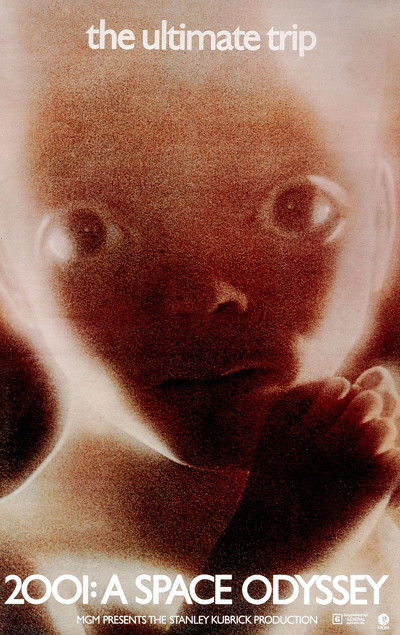
In the nihilistic Me Generation of THE EXORCIST and THE OMEN,
marketing for 2001: A SPACE ODYSSEY took a decidedly creepy turn
In 1976, when broadcast TV was finally able to show its audience 2001, MGM allowed Marvel comics to make an Official Adaptation of 2001, drawn by no less than their master artist of the time, Jack Kirby.
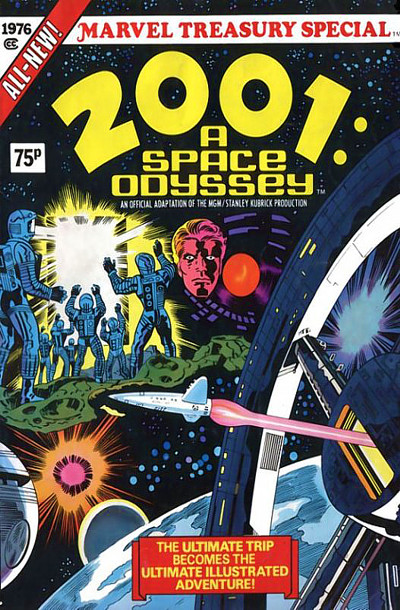
A comic book series which immediately went to hell with their "Second Startling Issue". Beginning with the originality of Stanley Kubrick, Arthur C. Clarke, and Carl Sagan at their best, Stan Lee couldn't wait to turn it into Roger Corman at his absurd worst.
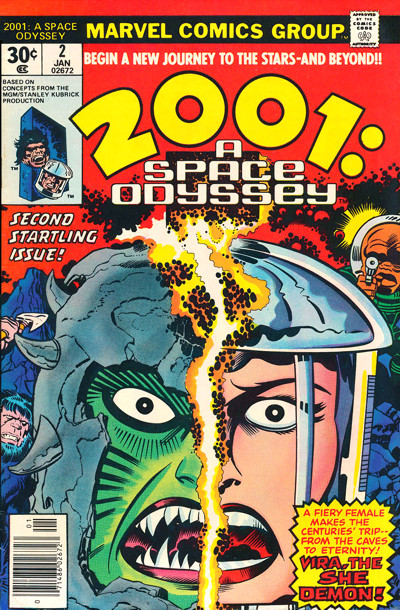
Comic books aside, with each decade's re-release, marketing took Kubrick's 2001 farther and farther from the visionary science and deeper and deeper into the personal terror.
50 years later, 2001 remained the Ultimate Trip.
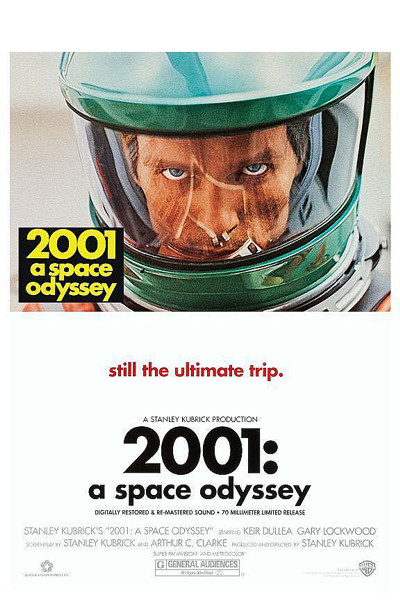
At no point were any of these reboots or re-edits. Unlike Kubrick's THE SHINING, his 2001: A SPACE ODYSSEY remained the exact same movie throughout the decades. Yet with the remodeled marketing scheme and the different expectations it brought, HAL 9000 (voiced by Douglas Rain), the killer computer, took center stage in the minds and memory of the audience.
2001 Trailer of 2014
2001 is currently billed as the One Movie That Changed All Movies.
That's a stretch, athough as I sat there overwhelmed by the introduction of the massive Discovery One spaceship on an IMAX screen, only then did I realize that George Lucas imitated this moment at the start of Star Wars with his Imperial ship chasing down the smaller spaceship.
It was repeated again with the introduction of the massive ore ship in ALIEN.
Watching the 70mm movie, with a sound system that fully immersed me in the experience, and having watched the movie so many times before, I never-the-less felt a fearfulness of HAL I don't remember experiencing before.
The calm indifference of its voice when it is in control. The scary seeping of emotion into its narrative when that control is threatened. The return of that indifference when it has the upper hand.
To Kubrick's credit, there is no sound in space in 2001: A SPACE ODYSSEY. The silence is carried either through music or the astronaut's own breathing or, when no one is out of the craft, silence itself.
This silence becomes so oppressive that the isolation of the astronauts, whose lives depend upon a computer that is going mad, becomes harrowing. They have no means of escape, they are entirely reliant upon their tools to survive the death of space and, on top of everything else, they are rapidly moving toward what may be an even greater danger: the unknown alien intelligence that created the monoliths.
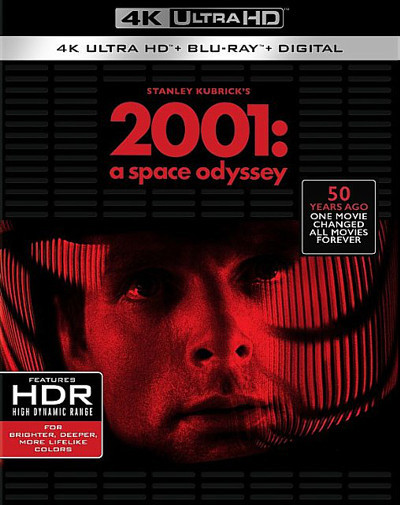
2001: A SPACE ODYSSEY now endures not as an
"Epic drama of adventure and exploration", as
Stanley Kubrick intended, but as a work of Horror.
Stanley Kubrick fulfilled his vision of "the proverbial good science fiction movie". 2001: A SPACE ODYSSEY is pure science fiction. It is also Stanley's first slow-building journey into Terror.
As for Arthur C. Clarke's original novel? It is no longer marketed as Science Fiction, but as a Techno-Thriller.
Five Shriek Girls.





This review copyright 2018 E.C.McMullen Jr.

|
| GET COVERED | |
| YOU MIGHT ALSO LIKE THESE (Sub-Section: ALTERNATE REALITY) |
|||
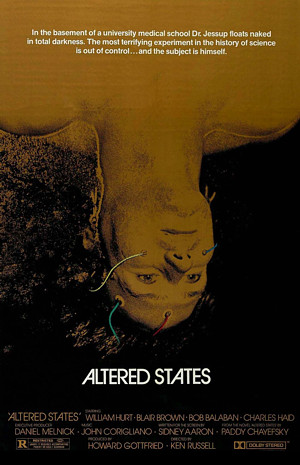 |
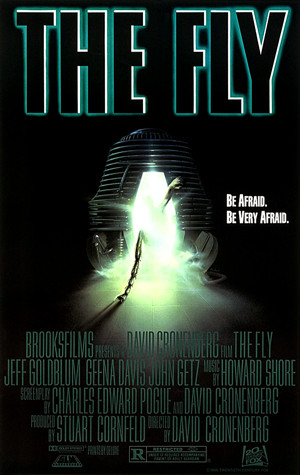 |
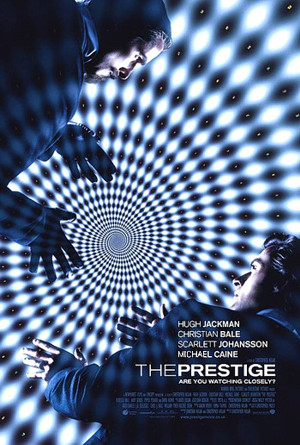 |
|
| ALTERED STATES MOVIE REVIEW |
THE FLY MOVIE REVIEW |
THE PRESTIGE MOVIE REVIEW |
|
FEO AMANTE'S HORROR THRILLERCreated by:E.C.McMullen Jr. FOLLOW ME @ |
| Amazon |
| ECMJr |
| Feo Blog |
| IMDb |
| Stage32 |
| X |
| YouTube |
| Zazzle Shop |

